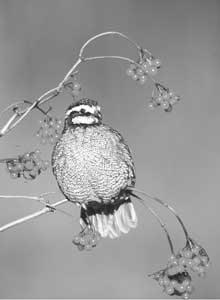
Wild quail still to be had in La.
I was programmed as a hunter from the start, and the start for me has been some time ago. One of the biggest thrills of my youth was to go bird hunting with my uncle. It was quite a rush to walk up to the dogs on point, thinking a covey was there, and still be surprised by the eruption of a dozen brown rockets.
I was usually lucky to recover in time to nail a few over the course of a frosty morning’s hunt. I did more shooting than killing, but what fun.
In those times in many a quiet southern town, a man’s status wasn’t associated with his job, house or car, but his bird dogs and their ability to hunt quail. Bird dogs, usually English pointers or setters, and quail hunting were an integral part of the southern sporting scene.
But things have changed in the South the last several decades. While other game species, such as deer and turkeys, have recovered and now flourish throughout, northern bobwhites have consistently diminished. The once common whistle of the calling cock bobwhite has been replaced by the gobble of the wild turkey.
So, what’s happened? Habitat is a key ingredient for any species, and quail have suffered from habitat loss and degradation. Quail are associated with early successional weedy vegetation with native legumes and some bare ground, such as fallow fields, field borders, small weedy gardens and young forest clearcuts. The suitable habitat condition is very temporary, and has been maintained by disturbance, such as the plow or fire.
Now our land-use practices are too efficient in producing the target crops to allow much for quail. Our agricultural fields are too large, clean and weed free.
Permanent pasture, such as Bermuda grass or fescue, is too dense for the young chicks, and there’s little for the birds to eat.
Many of our forest stands are too dense and mature for this species. Also the use of fire in forests has been seriously reduced.
There may be other confounding factors that interact with less-suitable habitat.
Predators play a role. Hawks and owls take some quail, and numbers may have increased in recent years. Middle-sized mammals, such a raccoons and skunk, suffer little trapping pressure now, and have always enjoyed a quail nest meal.
Rat snakes are another consistent quail predator; they’re programmed to eat eggs and young birds of tree nesters as well as ground nesters.
And fire ants play an ecological role. Even if they don’t kill many recently hatched chicks, they compete with young chicks for insects.
But still, habitat is the key.
So can anything be done? Maybe, in some places. There is a northern bobwhite and grassland bird task force, led by Fred Kimmel of the Louisiana Department of Wildlife and Fisheries, that is exploring how and where can quail be promoted.
Landowners interested in managing for quail can check with their parish National Resource Conservation Service for technical guidance and assistance.
So where around Louisiana can someone find enough wild quail to hunt? The places that come to mind are large areas where broad-scale disturbance has left some open ground with a sparse weedy cover not too thick.
Areas on the Kisatchie National Forest where a regular burning regime has been followed produce quail, and Jackson Bienville Wildlife Management Area in North Louisiana has substantial early succession vegetation with the pines, and has decent quail numbers.
Other reasonable prospects in Louisiana according to Kimmel, include Fort Polk, Camp Beauregard, Sabine, West Bay and Boise-Vernon WMAs.
More distant suitable habitat includes the shortleaf pine bluestem restoration portion of the Ouachita National Forest in western Arkansas, where a regular burning regime has increased quail numbers substantially.
In westerly rangeland, such as Texas and Oklahoma, the landscape probably hasn’t changed as much as in the southeast. In dryer western areas, quail populations depend on range conditions, determined by rainfall and grazing pressure.
Bobwhites have high productivity, 12 to 14 young per nest, so populations have responded quickly to the favorable conditions there. I saw a lot of quail while turkey hunting in west Texas last spring. They’re doing well there now.


